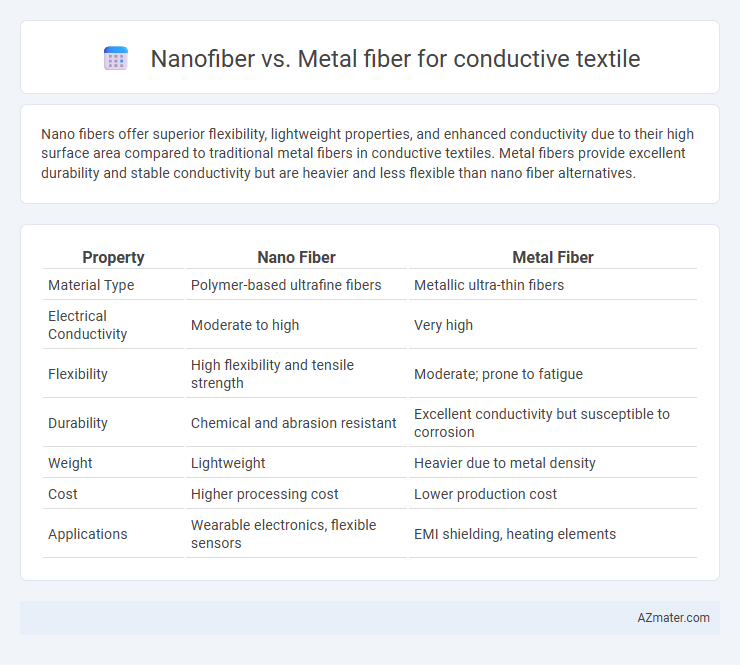Nano fibers offer superior flexibility, lightweight properties, and enhanced conductivity due to their high surface area compared to traditional metal fibers in conductive textiles. Metal fibers provide excellent durability and stable conductivity but are heavier and less flexible than nano fiber alternatives.
Table of Comparison
| Property | Nano Fiber | Metal Fiber |
|---|---|---|
| Material Type | Polymer-based ultrafine fibers | Metallic ultra-thin fibers |
| Electrical Conductivity | Moderate to high | Very high |
| Flexibility | High flexibility and tensile strength | Moderate; prone to fatigue |
| Durability | Chemical and abrasion resistant | Excellent conductivity but susceptible to corrosion |
| Weight | Lightweight | Heavier due to metal density |
| Cost | Higher processing cost | Lower production cost |
| Applications | Wearable electronics, flexible sensors | EMI shielding, heating elements |
Introduction to Conductive Textiles
Nano fibers offer superior surface area and flexibility compared to metal fibers, enhancing conductivity and comfort in conductive textiles. Metal fibers provide excellent electrical conductivity and durability but can add stiffness and weight to the fabric. Conductive textiles leverage these materials to integrate electronic functionality seamlessly into wearable technology and smart fabrics.
Understanding Nano Fibers
Nano fibers exhibit exceptional electrical conductivity due to their high surface-area-to-volume ratio and nanoscale dimensions, making them ideal for advanced conductive textiles. These fibers enhance fabric flexibility, breathability, and durability while maintaining consistent conductivity, outperforming traditional metal fibers, which can be heavier and prone to oxidation. Understanding nano fibers' unique properties allows for the development of lightweight, efficient, and highly sensitive wearable electronics and smart textiles.
Overview of Metal Fibers
Metal fibers used in conductive textiles typically consist of stainless steel, copper, or silver, known for their excellent electrical conductivity and durability. These fibers enhance textile performance by providing consistent conductivity, corrosion resistance, and mechanical strength, making them ideal for electromagnetic shielding and wearable electronics. Their larger diameter compared to nanofibers results in higher conductivity but lower flexibility and comfort in textile applications.
Electrical Conductivity: Nano Fiber vs Metal Fiber
Nano fibers in conductive textiles offer high surface area and enhanced flexibility, resulting in improved electrical conductivity through more efficient electron pathways at the nanoscale. Metal fibers, such as silver or copper, provide inherently higher bulk electrical conductivity but can be less flexible and prone to oxidation, which diminishes performance over time. Combining nano fibers with metal coatings or blends can optimize electrical conductivity while maintaining durability and textile comfort.
Flexibility and Comfort Comparison
Nanofibers offer superior flexibility and enhanced comfort in conductive textiles due to their ultra-fine diameter and high surface area, which enable seamless integration with fabric fibers without compromising softness. Metal fibers, while providing excellent electrical conductivity, tend to be stiffer and less breathable, often resulting in reduced comfort and limited flexibility in wearable applications. The lightweight and pliable nature of nanofiber-based conductive textiles makes them ideal for dynamic, body-conforming garments requiring both conductivity and wearability.
Durability and Washability Factors
Nano fibers in conductive textiles offer enhanced durability due to their high tensile strength and resistance to mechanical stress, outperforming conventional metal fibers that may suffer from brittleness and corrosion. The washability of nano fiber-based conductive fabrics is superior, maintaining conductivity after multiple wash cycles thanks to their strong adhesion and flexibility. Metal fiber textiles often degrade in performance with repeated laundering as metal particles can oxidize or detach, leading to reduced conductivity over time.
Breathability and Fabric Performance
Nanofibers enhance breathable conductive textiles by providing a high surface area-to-volume ratio, enabling efficient moisture vapor transmission and maintaining lightweight fabric performance. Metal fibers offer excellent electrical conductivity but often compromise breathability due to increased material density and reduced porosity. Optimizing conductive textiles involves balancing nanofiber integration for superior breathability with metal fiber inclusion to achieve desired electrical performance without significantly hindering fabric comfort.
Cost and Scalability Considerations
Nanofiber conductive textiles offer lower material costs and compatibility with large-scale electrospinning techniques, enabling efficient mass production at reduced expenses compared to metal fibers. Metal fiber textiles, while providing superior conductivity, often incur higher raw material costs and complex fabrication processes that limit scalability and increase overall production costs. Cost-effective scalability in nanofiber conductive textiles makes them preferable for widespread applications requiring affordable and flexible conductive materials.
Application Areas: Nano vs Metal Fiber
Nano fibers offer superior flexibility and lightweight properties ideal for wearable sensors and smart fabrics in healthcare and sportswear applications. Metal fibers excel in EMI shielding, anti-static protection, and heating elements, making them suitable for aerospace, automotive, and industrial safety textiles. The choice depends on the required conductivity, durability, and specific industry standards in electronics integration or protective clothing.
Future Trends in Conductive Textile Technologies
Nano fibers offer superior electrical conductivity and flexibility compared to traditional metal fibers, making them ideal for next-generation wearable electronics. Advancements in nanomaterial composites and scalable fabrication techniques are driving the integration of nano fibers into smart textiles with enhanced durability and sensitivity. Future trends emphasize hybrid conductive textiles combining nano fibers and metal fibers for optimized performance in medical sensors, flexible displays, and energy harvesting devices.

Infographic: Nano fiber vs Metal fiber for Conductive textile
 azmater.com
azmater.com